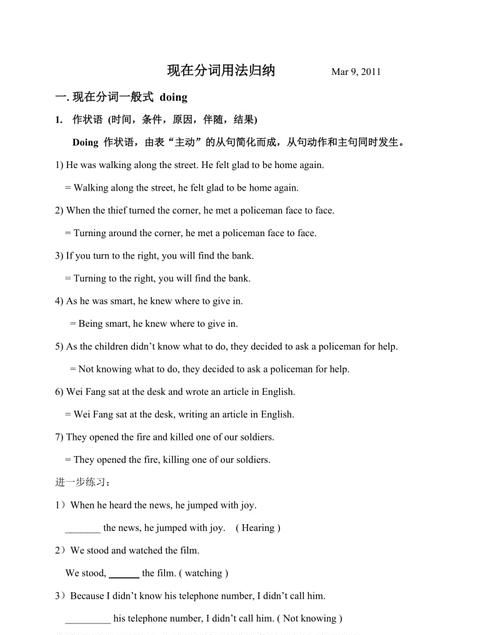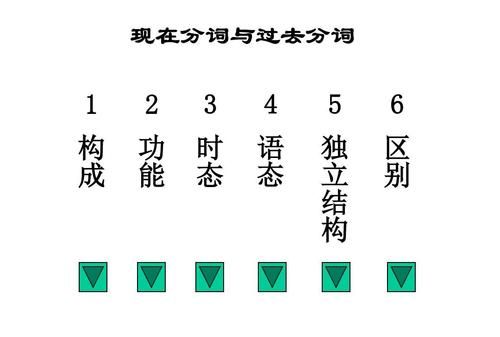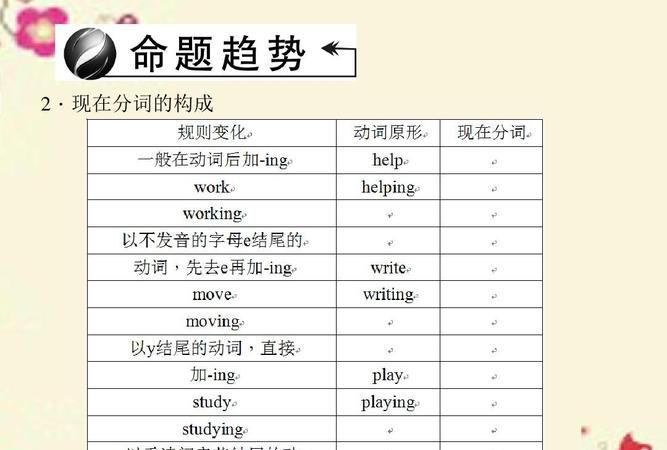本文目录
动词的现在分词形式是什么意思
希望能帮到大家☺️
(1) 一般情况下,在动词后加 -ing 构成: work→working 工作 sleep→sleeping 睡 wait→waiting 等待 study→studying 学习 read→reading 读 talk→talking 谈话 (2) 以不发音的e结尾的动词去掉e 后再加 -ing: smile→smiling 微笑 move→moving移动 write→writing 写 但是,若是发音的 e 结尾,则不能去 e: see→seeing 看见 agree→agreeing 同意 (3) 以重读闭音节或 r 音节结尾且末尾只有一个辅音字母的动词,要双写末尾的辅音字母再加 -ing: sit→sitting 坐 plan→planning 计划 prefer→preferring 宁愿 (4) 以字母 ie 结尾的动词,通常将 ie 改为 y,再加 -ing: die→dying 死 lie→lying 躺 ① 以字母l结尾的动词,若末尾一个音节为重读音节,则必须双写l再加-ing,如control / controlling;但若末尾一个音节为非重读音节,则可双写l(英国英语)或不双写l(美国英语),如travel / travel(l)ing。 ② 名词变复数、形容词和副词变比较级和最高级、动词变过去式和过去分词等都有“改y规则”,但动词的现在分词没有“改y规则”。

现在分词的构成
现在分词的构成:a)在一般情况下,在动词原形后直接加词尾 –ing。 eg. go – going; do – doing; ask – asking; read --- reading 特别要注意:这和第三人称一般现在时的词尾变化不同,动词词尾如为“辅音字母 + y” 时不变,在其后直接加 –ing。 eg. study – studying; carry – carrying; fly – flying; worry – worrying; b) 在以不发音的e 结尾的动词后,去掉e,再加- ing。 eg. come – coming live – living dance – dancing make – making c)在闭音节的单音节动词后、以重读闭音节结尾的多音节动词,而末尾只有一个辅音字母时,将这个辅音字母双写(x除外),然后再加 –ing.

现在分词的七种用法思维导图
(一)作定语
1. 动词现在分词单独作定语,通常放在所修饰词前。The sleeping boy is Tom.
2. 现在分词短语作定语放在所修饰词的后面,意思同定语从句差不多。例如 :
Tell the children playing outside not to make too much noise. = Tell the children who are playing outside not to make too much noise.
3.现在分词可相当于非限制性定语,常用逗号分开。
Tom,wearing beautiful clothes, followed me down the hill. = Tom, who is wearing beautiful clothes, followed me down the hill.
4. 有时现在分词可以和副词或名词构成复合词作定语。This is an English-speaking country.
(二)作表语
现在分词作表语多表示主语的特征。如amusing,
discouraging, puzzling, refreshing, astonishing, exciting 等。
The story is moving.
(三)现分在句中作宾语补足语 ,这时现在分词和前面的宾语有逻辑上的“主表”关系或“主谓”关系。
We
all found his equipment interesting. (主表关系) I saw Mary going upstairs then. (主谓关系)
(四)作状语 现在分词作状语,其逻辑主语一般是句中的主语,如果不是,需在V-ing 形式前加名词或代词主格作逻辑主语。
1. 作原因状语,相当于原因状语从句。Being ill, Mary didn't come to school yesterday.
2. 作时间状语,相当于时间状语从句。Seeing their teacher coming, the students stopped talking.
如果现在分词表示的动作与谓语表示的动作同时发生,常在现在分词前加上when或while。
While waiting for the plane, I had a long talk with Simon.
3. 作条件状语。
V-ing形式作条件状语时,相当于一个条件状语从句。Working harder, you'll be No. 1 in your class.
4. 作让步状语,相当于让步状语从句。Weighing almost two hundred jin, the stone was moved by him alone.
5. 作结果状语。 He died, leaving nothing but debts.
6. 作伴随状语或方式状语。 He sat by the roadside, begging.
(五)现在分词的完成式表示它发生在主句谓语动词表示的动作之前。
Having finished his homework, he left the classroom.
(六) 现在分词的被动式
当句子的主语是动作的承受者时,用V-ing 形式的被动式The factory being built now is a big one.
(七) 现在分词的否定形式是由“not + 现在分词”构成。
Not having been invited to the party, she had to stay home.

现在分词的构成规则的口诀
1.
形式:现在分词v-ing,
过去分词v-ed
(不规则的要专门查辞典)
2
在句中的用法与区别
.a.用在名词前(或后)修饰名词,作定语。此时,现在分词表示“正在进行、发生”和“主动”;过去分词表示“以完成的动作”或、和“被动”。
具体例子(1)分词在名词前:
falling
leaves
(正在漂落的树叶),
fallen
leaves
(躺地上的)落叶
又如我们平时说喝开水
boiled
water(烧开过的),
boiling
water
(正在沸腾的)开水
(2)分词在名词后
a
man
standing
under
the
tree
(正)站在树下的男子
a
thief
caught
in
the
station
已被抓的小偷
b.
用在句中谓语位置,
现在分成表示“正在进行”,过去分词表示“被动”
具体例子:the
man
is
standing
under
the
tree.
the
thief
was
caught
in
th
station.
c.
作为非谓语动词,在句中作为状语(原因,时间,条件等),
现在分词表示与主语为主动(主谓关系),过去分词表示与主句主语被动(动宾关系)
具体例子:
standing
under
the
three,
the
man
is
waitig
for
the
girl
to
appear
again.
given
another
chance,
we
can
do
it
better.

以上就是关于现在分词的构成语法3种 ,动词的现在分词形式是什么意思的全部内容,以及现在分词的构成语法3种 的相关内容,希望能够帮到您。
